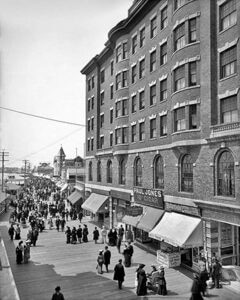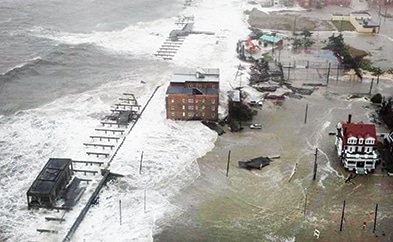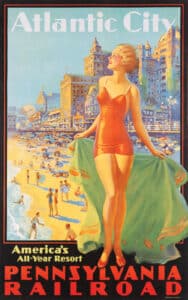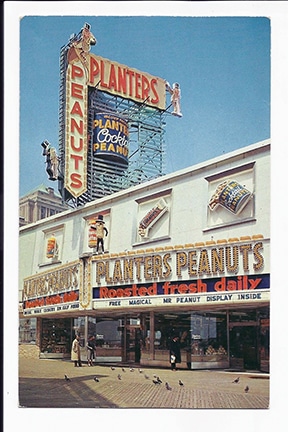by Maxine Carter-Lome, publisher

Atlantic City, New Jersey is home to one of the most famous and oldest boardwalks in America. This initially mile-long wooden walkway from the beach into the town was erected in 1870 to solve a problem not anticipated by the Town’s developers in the building of this seaside resort and tourist destination: beach sand. Wealthy visitors could walk out of their posh resort hotel with ocean views and onto the beach but they didn’t want to take off their shoes and walk on the sand.
Hoteliers on the beach were tired of guests dragging sand into their lobbies and guest rooms. Even train operators complained of sand in their cars after an Atlantic City run. It was a problem that needed to be managed for the sake of the tourist trade.

The idea of a temporary wooden “walk- way” on top of the sand was pitched to the town by Alexander Boardman, a railroad conductor, and Jacob Keim, a hotelier. With the support of the hotels, developers, and rail lines, the Town spent five thousand dollars to build a mile-long, 10-foot-wide walkway constructed from wooden planks in sections of 12 feet, arranged in rectangular patterns known as a herringbone pattern. It was also designed to be dismantled after the “season” and then stored during the winter months.
This first Atlantic City Boardwalk was dedicated on June 26, 1870, and was quickly embraced by visitors and welcomed by commerce. Yet it would be years before the idea of turning the walkway into a tourist destination was put into motion. For now, it was nothing more than a practical solution and public conveyance for walking along the beach without walking on the sand. No commerce of any kind was allowed within thirty feet of the walk for the next decade.
Mother Nature Changes Everything
Fast forward 10 years later, and the issue of the Boardwalk was once again in front of the city council. This time it was about the need to replace and enhance the weathered and splintered but highly popular walkway. Building a replacement boardwalk presented an opportunity for developers to re-imagine the walkway as a more integral part of the Atlantic City vacation experience.
The next iteration was built four feet wider (14’) and much longer. The Council also gave the “green light” for commerce to move within ten feet of the walkway. Within a few short years, the 10’ foot ordinance was “tossed to sea” and by 1883, almost one hundred stores, stalls, and stands had Boardwalk addresses. Now, there was more to see and do while on the Boardwalk than just watching the waves roll in.
A storm a year later destroyed the newly-built Boardwalk but not the interest in rebuilding it, especially in a way that made it less vulnerable to the elements.
In its third iteration, the Boardwalk was elevated atop pilings five feet high above the beach so the tides could wash beneath safely. There were no railings on this elevated walkway, and accounts were told of at least somebody every day falling off the boards, usually in the act of flirting. The Boardwalk was also widened to 20-feet to accommodate shops, walkers, and the new rolling chairs introduced in the 1880s, which offered visitors a novel way to relax and enjoy the sites along what was now a two-mile-long strip.
On Sunday, September 9, 1889, another devastating hurricane hit the island. Most of the city was under 6 feet of water and the boardwalk was once again destroyed. There was still a strong commitment to bringing the Boardwalk back, and this time better than ever. This fourth iteration was 24-feet wide, 10 feet high, nearly 4 miles long, and had railings on both sides.
Over the next half-century, the Boardwalk underwent additional expansions and section replacements to repair storm damage and accommodate its popularity and evolution as a tourist attraction and cultural landmark.
The Boardwalk of today, with its origins in the 1916 iteration, is 60-feet wide and six miles long. Its planks, placed in a herringbone pattern, are laid on a substructure of concrete and steel. Steel railings are in place to keep visitors from falling off to the beach below, and under an old City Council ordinance, hotels, restaurants, and shops are kept on one side of the boards, with amusement piers on the other.

Weather continues to play a role in the Boardwalk’s physical and structural evolution, most recently Hurricane Sandy in 2012 wiped out the oldest section of the Boardwalk which was already slated for demolition.
The real story behind the evolution of the Atlantic City Boardwalk, however, is less about its construction and more about the attractions and experiences that brought tourists from all over the world to this small seaside town on the New Jersey shore.
The Boardwalk Grows Up with the Times
It was the inspiration of Dr. Jonathan Pitney, considered the “Father of Atlantic City,” to develop Atlantic City as a health resort. Pitney believed that where the train stopped commerce would surely flourish, and convinced the municipal authorities that a railroad to the beach would be beneficial to the town. He also engaged Samuel Richards, an entrepreneur and member of the most influential family in southern New Jersey at the time, in his scheme to get in on the ground floor of building a town to meet the train and its passengers when they arrived. The first rail passengers arrived in Atlantic City on July 1, 1854, aboard the Camden and Atlantic Railroad through Camden, New Jersey.
In the coming years, the city’s luxurious hotels, fine restaurants, alluring shops, and a connecting railroad line through to Philadelphia drew visitors from all over the world to Atlantic City’s beautiful beaches and fresh sea air. Atlantic City became a popular summer resort and winter health spa for the well-to-do, and a getaway for bathers looking to escape the city for a day at the beach.
By 1874, almost 500,000 passengers a year were coming to Atlantic City by rail to enjoy a memorable vacation by the sea. Defining the town along its coastline was a wooden walkway over the sand that was both a novel and refined way to enjoy the beach without getting sandy.
The 1920s was the decade that really put Atlantic City on the tourist map. Posh hotels, shops, shows, top talent, the original Miss America pageant, and parades were all part of the Boardwalk experience, as was the daily spectacle of fashionably dressed men and women promenading down the Boardwalk wanting to be “seen.” Atlantic City was a popular honeymoon spot, and the Boardwalk, with its Steel Pier, a must-experience tourist attraction. In 1929, just months before the stock market and U.S. economy crashed, the New York Times toasted the Boardwalk as “a magnificent proof of America’s newly found wealth and leisure. It is an iridescent bubble on the surface of our fabulous prosperity.”
Wartime in the 1940s also made some Boardwalk memories. Convention Hall, located right on the Boardwalk, was then serving as a training facility, preparing thousands of young soldiers for service. Squads of armed forces could be seen marching up and down the boards. Mock beachfront invasions and war bond rallies were common as well. As 1942 rumors began flying that German U-boats were on the watch along the coast, Boardwalk lamps were shaded for protection.

ca. 1935 by Edward M. Eggleston
The 1950s and 1960s gave the Boardwalk its star power. Marilyn Monroe, Jimmy Durante, Ed Sullivan, Joe DiMaggio, Frank Sinatra, Milton Berle, Dean Martin, and Bing Crosby all enjoyed and entertained on the Boardwalk. The Beatles were filmed enjoying its world-famous sub sandwiches, Annette Funicello and Frankie Avalon opened a bowling alley, and scenes from The Burgler with Jayne Mansfield made it a backdrop. The city was such a hot spot that it inspired the popular board game Monopoly, which is based on Atlantic City streets and properties.
In the 1960s, international rather than domestic travel became popular with the affordability of air travel, and Atlantic City was forsaken in favor of a European vacation. The groundbreaking decision to bring casino gaming to the fading beach resort in 1978 allowed Atlantic City to revive and reinvent itself and offered new hope for the Boardwalk, which by this time had seen better days, falling from the main attraction to a kitchy sideshow.
With the legalization of gambling, hotels, stores, property owners, and piers along the Boardwalk started to change hands rapidly like deeds in a game of MONOPOLY. Billions were invested by out-of-town developers to build grand casinos and launch popular restaurants on and off the Boardwalk. Stars and big-name talent were paid top dollar to perform or game at the tables. Yet, for all that was spent and for all the publicity that was launched around casino openings, the vision of Atlantic City as the Las Vegas of the east coast never materialized for investors and the many side businesses that banked on Atlantic City’s allure and come-back. Several of the casinos and properties developed during this boom have since been demolished. For now, this seaside town and its cultural landmark, the Atlantic City Boardwalk, survive on nostalgia while waiting for what comes next.
Boardwalk Favorites
In June of 1898, the Steel Pier opened as an amusement pier off the Boardwalk and quickly became one of the most famously known theme parks and attractions in the country. It earned its reputation over the decades for hosting an array of concerts, unusual shows, and the greatest entertainers of the times. It was called “The Showplace of the Nation!” and featured such attractions as the Diving Horse, High Divers, Human Cannonball, Motor Cycle Cage, and Diving Bell. A fire destroyed a major portion of the Steel Pier in 1969, and Atlantic City’s waning tourist popularity in the 1970s ultimately led to its closing in 1976. A second fire in 1982 destroyed what remained of the original structure.
Any consideration of the Boardwalk demands at least a nod to saltwater taffy, a favorite beachside treat. Along the Atlantic City Boardwalk folks have purchased the product since at least the early 1880s. Many candy shops along the Boardwalk provided windows for passerby to watch the taffy being stretch. You could buy taffy there to enjoy and take some home as a souvenir gift, the most popular being an assortment of taffy flavors packaged inside a barrel-shaped bank.

Mr. Peanut store on the boardwalk
Mr. Peanut was another staple on the Atlantic City Boardwalk. In 1930, the Planters company opened a peanut shop on the Boardwalk across from the Steel Pier. There were peanut roasters in the window and the aroma of freshly roasted peanuts spread out the door and all along the boardwalk. Said local historian Allen “Boo” Pergament, “when you’d smell those roasting nuts coming out of the store, you just had to have a bag.” Outside there was a man dressed up in a peanut costume, who handed out samples of the roasted peanuts, waved to passersby, and greeted visitors to the Planter’s Peanut store. This was Mr. Peanut, who was a Boardwalk tourist attraction until the store closed its doors in 1978. Today, in its stead, stands the Hard Rock Hotel and Casino. Left behind are over 45 years of Mr. Peanut collectibles, from figurines to banks, buttons, peanut-shaped boxes, and glass counter jars. Many of these items can be found at the Mr. Peanut store on eBay.
Soon, the Boardwalk became all about food, from chocolates to ice cream, roasted peanuts, fudge, confections, cotton candy, pizza, and submarine sandwiches. The Boardwalk introduced Americans and tourists from abroad to the latest tastes, treats, and food sensations; food worth talking about and taking home as a souvenir. Today, the Boardwalk continues to be all about the food experience – from new sensations to traditional favorites, offering fun and affordable alternatives to the more formal and fine dining options offered by the casinos and restaurants in town.
The other great attraction was the introduction of the rolling chair to the Boardwalk. The first ones, designed by William Hayday in 1887, were modified wooden wheelchairs that allowed people with limited mobility to experience the sea breezes. To be sure the chairs he rented were returned to his shop and not abandoned at railroad stations or bathhouses, he offered the option of hiring a man to push the chairs for the day. Its novelty was not lost on the able-bodied, and soon it became popular for gentlemen and ladies to dress to the nines for a push up and down the Boardwalk in a rolling chair. Over the years, the chairs have evolved in look and are now mostly motorized or bike-pedaled, but the experience is the same – the rolling chair remains the best seat in the house for seeing and being seen on the most iconic of American boardwalks.
For a vintage look at Atlantic City, visit: www.historydaily.org/atlantic-city-in-the-1900s





Related posts: